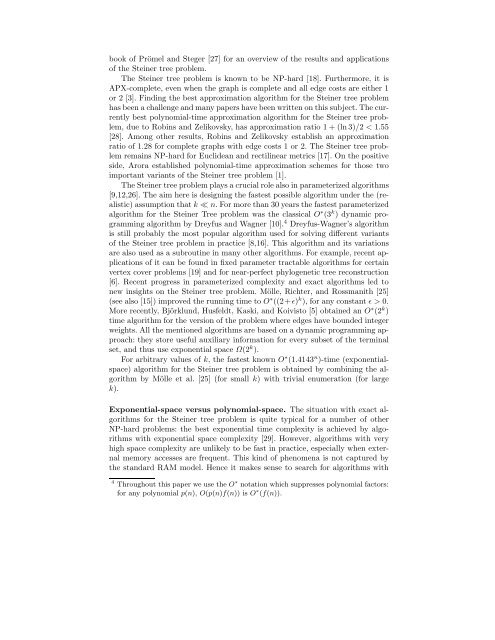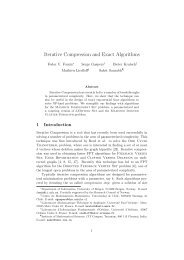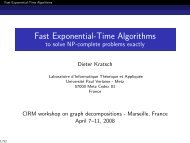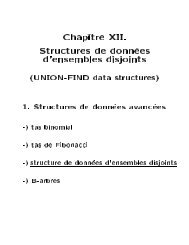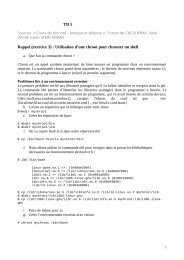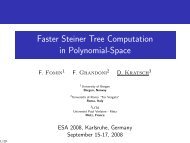Fast Steiner tree computation in polynomial space - Lita
Fast Steiner tree computation in polynomial space - Lita
Fast Steiner tree computation in polynomial space - Lita
You also want an ePaper? Increase the reach of your titles
YUMPU automatically turns print PDFs into web optimized ePapers that Google loves.
ook of Prömel and Steger [27] for an overview of the results and applications<br />
of the <strong>Ste<strong>in</strong>er</strong> <strong>tree</strong> problem.<br />
The <strong>Ste<strong>in</strong>er</strong> <strong>tree</strong> problem is known to be NP-hard [18]. Furthermore, it is<br />
APX-complete, even when the graph is complete and all edge costs are either 1<br />
or 2 [3]. F<strong>in</strong>d<strong>in</strong>g the best approximation algorithm for the <strong>Ste<strong>in</strong>er</strong> <strong>tree</strong> problem<br />
has been a challenge and many papers have been written on this subject. The currently<br />
best <strong>polynomial</strong>-time approximation algorithm for the <strong>Ste<strong>in</strong>er</strong> <strong>tree</strong> problem,<br />
due to Rob<strong>in</strong>s and Zelikovsky, has approximation ratio 1 + (ln 3)/2 < 1.55<br />
[28]. Among other results, Rob<strong>in</strong>s and Zelikovsky establish an approximation<br />
ratio of 1.28 for complete graphs with edge costs 1 or 2. The <strong>Ste<strong>in</strong>er</strong> <strong>tree</strong> problem<br />
rema<strong>in</strong>s NP-hard for Euclidean and rectil<strong>in</strong>ear metrics [17]. On the positive<br />
side, Arora established <strong>polynomial</strong>-time approximation schemes for those two<br />
important variants of the <strong>Ste<strong>in</strong>er</strong> <strong>tree</strong> problem [1].<br />
The <strong>Ste<strong>in</strong>er</strong> <strong>tree</strong> problem plays a crucial role also <strong>in</strong> parameterized algorithms<br />
[9,12,26]. The aim here is design<strong>in</strong>g the fastest possible algorithm under the (realistic)<br />
assumption that k ≪ n. For more than 30 years the fastest parameterized<br />
algorithm for the <strong>Ste<strong>in</strong>er</strong> Tree problem was the classical O ∗ (3 k ) dynamic programm<strong>in</strong>g<br />
algorithm by Dreyfus and Wagner [10]. 4 Dreyfus-Wagner’s algorithm<br />
is still probably the most popular algorithm used for solv<strong>in</strong>g different variants<br />
of the <strong>Ste<strong>in</strong>er</strong> <strong>tree</strong> problem <strong>in</strong> practice [8,16]. This algorithm and its variations<br />
are also used as a subrout<strong>in</strong>e <strong>in</strong> many other algorithms. For example, recent applications<br />
of it can be found <strong>in</strong> fixed parameter tractable algorithms for certa<strong>in</strong><br />
vertex cover problems [19] and for near-perfect phylogenetic <strong>tree</strong> reconstruction<br />
[6]. Recent progress <strong>in</strong> parameterized complexity and exact algorithms led to<br />
new <strong>in</strong>sights on the <strong>Ste<strong>in</strong>er</strong> <strong>tree</strong> problem. Mölle, Richter, and Rossmanith [25]<br />
(see also [15]) improved the runn<strong>in</strong>g time to O ∗ ((2+ɛ) k ), for any constant ɛ>0.<br />
More recently, Björklund, Husfeldt, Kaski, and Koivisto [5] obta<strong>in</strong>ed an O ∗ (2 k )<br />
time algorithm for the version of the problem where edges have bounded <strong>in</strong>teger<br />
weights. All the mentioned algorithms are based on a dynamic programm<strong>in</strong>g approach:<br />
they store useful auxiliary <strong>in</strong>formation for every subset of the term<strong>in</strong>al<br />
set, and thus use exponential <strong>space</strong> Ω(2 k ).<br />
For arbitrary values of k, the fastest known O ∗ (1.4143 n )-time (exponential<strong>space</strong>)<br />
algorithm for the <strong>Ste<strong>in</strong>er</strong> <strong>tree</strong> problem is obta<strong>in</strong>ed by comb<strong>in</strong><strong>in</strong>g the algorithm<br />
by Mölle et al. [25] (for small k) with trivial enumeration (for large<br />
k).<br />
Exponential-<strong>space</strong> versus <strong>polynomial</strong>-<strong>space</strong>. The situation with exact algorithms<br />
for the <strong>Ste<strong>in</strong>er</strong> <strong>tree</strong> problem is quite typical for a number of other<br />
NP-hard problems: the best exponential time complexity is achieved by algorithms<br />
with exponential <strong>space</strong> complexity [29]. However, algorithms with very<br />
high <strong>space</strong> complexity are unlikely to be fast <strong>in</strong> practice, especially when external<br />
memory accesses are frequent. This k<strong>in</strong>d of phenomena is not captured by<br />
the standard RAM model. Hence it makes sense to search for algorithms with<br />
4 Throughout this paper we use the O ∗ notation which suppresses <strong>polynomial</strong> factors:<br />
for any <strong>polynomial</strong> p(n), O(p(n)f(n)) is O ∗ (f(n)).


